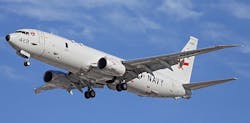Navy works with Boeing to prepare for building nine new Poseidon military planes
Officials of the Naval Air Systems Command at Patuxent River Naval Air Station, Md., are asking the Boeing Defense, Space & Security segment in Seattle acquire long-lead items for the manufacture and delivery of nine full-rate production Lot II P-8A maritime patrol and anti-submarine warfare (ASW) aircraft for the Navy.
The P-8A is a specially hardened and reinforced version of the Boeing 737 passenger jet, and is designed to operate either at extremely low altitudes or at high altitudes over the ocean to search for potentially hostile submarines. The P-8A is designed to withstand the rigors of low-altitude turbulence and exposure to salt spray.
Long-lead items for the P-8A represent either are difficult and time-consuming to procure or build, are funded early in the aircraft design process to keep overall production on schedule. Contracts to build the nine aircraft will come later.
The Poseidon is replacing the P-3 Orion for long-range maritime patrol and anti-submarine warfare. Navy officials plan to use the P-8A in tandem with the Northrop Grumman MQ-4C Triton Broad Area Maritime Surveillance (BAMS) unmanned aerial vehicle (UAV) -- a maritime-patrol version of the Global Hawk long-range surveillance UAV.
Plans call for using Triton to detect potentially hostile submarines and surface ships, and upon detection, to call in the P-8A to take a closer look or to attack hostile vessels with torpedoes and missiles.
Boeing is building the Poseidon aircraft at its factory in Renton, Wash., and its tail sections at Spirit AeroSystems in Wichita, Kan., then transferred to Renton where all structural features will be incorporated in sequence during fabrication and assembly.
The P-8A’s flight management system and the stores management system have been developed by GE Aviation Systems in Grand Rapids, Mich. (formerly Smiths Aerospace). The cabin has as many as seven operator consoles.
The Poseidon’s MX-20HD digital electro-optical and infrared (EO/IR) multi-spectral sensor turrets come from L-3 Communications Wescam in Burlington, Ontario. The MX-20HD is gyro-stabilized and can have as many as seven sensors, including infrared, CCDTV, image intensifier, laser rangefinder, and laser illuminator.
The aircraft has the upgraded APS-137D(V)5 maritime surveillance radar and signals intelligence (SIGINT) system from the Raytheon Co. Space and Airborne Systems (SAS) segment in McKinney, Texas.
The APS-137D(V)5 radar, which is installed on the P-8’s enlarged nose fairing, provides synthetic aperture radar (SAR) for imaging stationary ships and small vessels, coastal and overland surveillance, and high-resolution imaging synthetic aperture radar (ISAR) for imaging surfaced submarines and fast surface vessels operating in coastal waters.
For more information contact Boeing Defense, Space & Security online at www.boeing.com/defense, or Naval Air Systems Command at www.navair.navy.mil.
